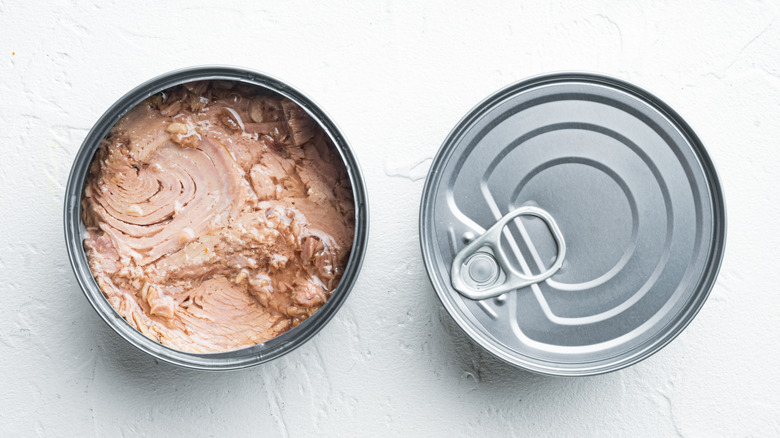Ever heard the saying, “Don’t judge a book by its cover”? Well, the same goes for canned fish. As you open that can of tuna or salmon, you may notice a mysterious white substance on the surface. It leaves you wondering, what exactly is this stuff? Is it safe to eat? And how does it affect the taste of your meal? Don’t worry, we’re here to satisfy your curiosity and put your mind at ease. In this article, we’ll uncover the truth about the white stuff in canned fish, debunking myths and providing you with useful information. Prepare to have your taste buds intrigued and your seafood knowledge expanded.
White Particles in Canned Fish
White particles in canned fish are often harmless and not a cause for concern. These particles could be natural occurrences, such as fish protein or fatty acids that have solidified. While they may appear unusual, they do not affect the nutritional value of canned fish. Canned fish, such as tuna, salmon, and sardines, are common types that are readily available. They offer a range of health benefits, including being a good source of omega-3 fatty acids, high-quality protein, and essential vitamins and minerals. Cooking techniques for canned fish are simple and versatile, including using them in salads, sandwiches, or pasta dishes. Consuming canned fish regularly can contribute to heart health, brain function, and overall well-being. Furthermore, sustainable fishing practices are essential for preserving fish populations and protecting the marine environment. Choosing canned fish products that are sourced from sustainably managed fisheries helps support these conservation efforts. Overall, the presence of white particles in canned fish is not a cause for concern and should not deter you from enjoying the nutritional benefits and delicious taste that canned fish can offer.
Causes of White Substance in Canned Fish
After discussing the harmless nature of white particles in canned fish, let’s now examine the factors that contribute to the presence of the white substance in canned fish.
Factors that contribute to the presence of the white substance in canned fish include:
- Common types of canned fish: Different types of fish may naturally have a higher amount of white substance. For example, tuna and salmon tend to have more visible white substance compared to other types of fish.
- Nutritional benefits of canned fish: Canned fish is packed with essential nutrients such as omega-3 fatty acids, protein, and vitamins. These nutrients, particularly the proteins, can contribute to the formation of the white substance.
- Cooking methods for canned fish: The cooking process for canned fish involves high heat and pressure, which can cause proteins to denature and solidify, resulting in the white substance. The amount of white substance can vary depending on the cooking time and temperature.
- Sustainable fishing practices for canned fish: The fishing practices used to catch the fish for canning can impact the quality of the fish. Sustainable fishing practices, such as using selective fishing gear and avoiding overfishing, can help ensure that the fish used for canning are of high quality and have minimal white substance.
Is the White Stuff in Canned Fish Harmful?
The presence of white substance in canned fish is a common occurrence, but is it harmful to consume? The white substance found in canned fish is actually coagulated protein, specifically albumin. Albumin is a natural occurrence in fish and is safe to eat. In fact, consuming canned fish can provide numerous health benefits. Canned fish, such as tuna, salmon, and sardines, are rich in omega-3 fatty acids, which are essential for brain function, heart health, and reducing inflammation. These fatty acids also contribute to healthy skin and can aid in weight loss. Additionally, canned fish is a great source of protein and contains essential vitamins and minerals. When it comes to cooking methods, it is important to note that the white substance may become more noticeable when fish is cooked at higher temperatures or using aggressive cooking methods. However, this does not affect the nutritional value of the fish. To minimize the presence of the white substance, consider cooking canned fish at lower temperatures for a longer time. It is also important to source canned fish sustainably to support the health of our oceans and ensure the longevity of fish populations.
How to Deal With the White Particles in Canned Fish
To effectively deal with the presence of white particles in canned fish, there are several steps you can take to ensure a smooth and enjoyable eating experience:
- Inspect the fish: Before consuming canned fish, visually inspect it for any visible white particles. While these particles are generally harmless, it is always good practice to check for any abnormalities.
- Rinse the fish: If you notice white particles on the surface of the canned fish, you can rinse it under cold water to remove them. This simple step can help improve the appearance and texture of the fish.
- Incorporate the fish into recipes: Canned fish, such as tuna or salmon, can be used in a variety of creative recipes. From salads to sandwiches, incorporating canned fish into your meals adds a nutritious boost to your diet.
- Choose sustainable options: When purchasing canned fish, opt for brands that prioritize sustainable fishing practices. This ensures that the fish populations are not depleted and that the ecosystem is not harmed.
Tips for Avoiding the White Substance in Canned Fish
To minimize the presence of the white substance in canned fish, there are a few tips that can be followed. First, consider alternative canned fish options. Tuna, for example, tends to have a higher likelihood of developing the white substance compared to other types of fish. Opting for canned salmon or sardines may help reduce the clumpy texture.
Another tip is to pay attention to the cooking techniques for canned fish. Overcooking canned fish can lead to the formation of the white substance. It is recommended to gently heat the fish or use it in recipes that require minimal cooking time. This can help preserve the texture and minimize the appearance of the white substance.
Proper storage of canned fish is also crucial in avoiding the white substance. Make sure to store the cans in a cool and dry place. Avoid exposing them to excessive heat or humidity, as these conditions can contribute to the formation of the white substance.


